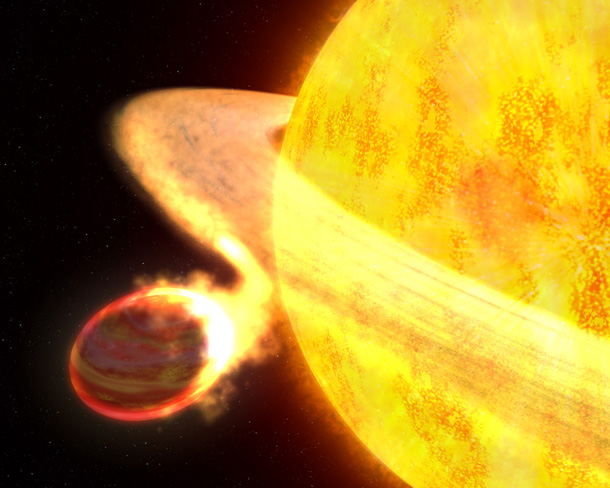600 light years away, in the constellation of Auriga, there is a star in some ways similar to our Sun. It’s a shade hotter (by about 800° C), more massive, and older. Oddly, it appears to be laced with heavy elements: more oxygen, aluminum, and so on, than might be expected. A puzzle.
Then, last year, it was discovered that this star had a planet orbiting it. A project called WASP - Wide Area Search for Planets, a UK telescope system that searches for exoplanets – noticed that the star underwent periodic dips in its light. This indicates that a planet circles the star, and when the planet gets between the star and us, it blocks a tiny fraction of the starlight.
The planet is a weirdo, for many reasons… but it won’t be weird for too much longer. That’s because the star is eating it.
OK, first, the planet. Called WASP 12b, it was instantly pegged as an oddball. The orbit is only 1.1 days long! Compare that to our own 365 day orbit, or even Mercury’s 88 days to circle the Sun. This incredibly short orbital period means this planet is practically touching the surface of its star as it sweeps around at over 220 km/sec (130 miles/sec)! That also means it must be very hot; models indicate that the temperature at its cloud tops would be in excess of 2200°C (4000° F).
Not only that, but other numbers were odd, too. WASP 12b was found to be a bit more massive and bigger than Jupiter; about 1.8 times its size and 1.4 times its mass. That’s too big! Models indicate that planets this massive have a funny state of matter in them; they are so compressible that if you add mass, the planet doesn’t really get bigger, it just gets denser. In other words, you could double Jupiter’s mass and its size wouldn’t increase appreciably, but since the mass goes up, so would its density.
But WASP 12b isn’t like that. In fact, it has a lower density than Jupiter, and is a lot bigger! Something must be going on… and when you see a lot of weird things all sitting in one place, it makes sense to assume they’re connected. In this case it’s true: that planet is frakking hot, and that’s at the heart of this mess. Heating a planet that much would not exactly be conducive to its well-being. When you heat a gas it expands, which would explain WASP 12b’s big size. It’s puffy! But being all bloated that close to a star turns out to be bad for your health.
Astronomers used Hubble to observe the planet in the ultraviolet and found clear signs of all sorts of heavy elements, including sodium, tin, aluminum, magnesium, and manganese, as well as, weirdly, ytterbium*. Moreover, they could tell from the data that these elements existed in a cloud surrounding the planet, like an extended atmosphere going outward for hundreds of thousands of kilometers.
That’s a long way from the planet. Any atom of, say, manganese that far from the planet would be caught in a tug-of-war between the gravity of the planet and the star… and the star would win. The gravity of the star is drawing material off the planet in a vast stream, or, in other words, the planet is getting slowly eaten by its star. If astronomers ever get around to giving this planet an actual name, I suggest Sarlacc†.
This explains the peculiar high abundance of heavy metals in the star I mentioned at the beginning of this post; they come from the planet! But not for long. Given the mass of the planet and the density of the stream, it looks like it has roughly ten million years left. At that point, supper’s over: there won’t be anything left for the star to eat. In reality it’s hard to say exactly what will happen; there may be a rocky/metal core to the planet that will survive. But even that is so close to the star that it will be a molten blob of goo. The way orbits work, the way the dance of gravity plays out over time, the planet itself may actually be drawn inexorably closer to its star. Remember, too, the star is old, and will soon start to expand into a red giant. So the planet is falling and the star is rising; eventually the two will meet and the planet will meet a fiery death.
All in all, it sucks to be WASP 12b.
But it’s cool to be an astronomer! Only 15 years ago we had no idea that there were other planets orbiting Sunlike stars, and now we know of over 400, and a lot of them are really, really bizarro. When I was a kid I watched Star Trek and read a lot of science fiction, and I remember thinking that the planets in them were too weird; there was no way anything like them could actually exist.
Ha! The Universe, as usual, is smarter and more clever than we are. There’s a lot of strange out there, and the more we look, the more we find.
* Admit it: you didn’t even know that was an element.
† Yes, I know, Star Wars fanbois, that that would be a better name for the star and not the planet, since Sarlacc was the creature that did the digesting, and was not itself digested. But if the star were Sarlacc, the planet would have to be named Boba Fett, and that’s just silly.
Artwork credit: NASA, ESA, and G. Bacon (STScI)
